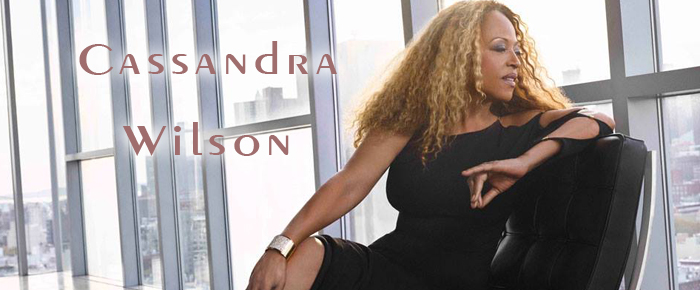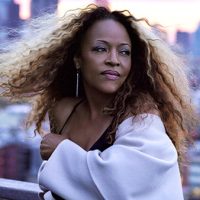
By Eleni P. Austin
20 years ago, it seemed as though Cassandra Wilson literally burst on the Jazz scene with her stunning New Moon Daughter album. Along with Diana Krall (and later, Norah Jones), she was introducing the uniquely American idiom to Starbucks’ drinkin’ Gen- X ears. But the truth is she had been a working musician since 1980.
Cassandra Wilson was born in Jackson, Mississippi in 1955. Her father was a guitarist and music teacher, her mother taught elementary school. She grew up listening to Motown and Jazz. As a child she studied piano and played clarinet. When she asked her father to teach her guitar, he handed her an instruction book and she taught herself. By high school she had appeared in myriad musical theatre productions, most notably starring as Dorothy in “The Wizard Of Oz.”
Higher learning took place at Millsaps College and Jackson State University. She studied by day and at night she made ends meet singing in a series of Pop, R&B and Funk cover bands.
After receiving a degree in mass communications Cassandra began her career in New Orleans working for local television station WDSU. But the pull toward music was too great, and with encouragement from Big Easy legends, Alvin Batiste and Ellis Marsalis, she quit her day job and moved to New York.
After relocating to the Big Apple, Cassandra began honing her craft. Heavily influenced by vocalists like Betty Carter and Abbey Lincoln, she received additional vocal training from trombonist Granchan Moncur III.
Jamming with like-minded musicians, she ended up joining the free-form collective, M-Base. Although the music was primarily improvisational and instrumental, Cassandra found a way to weave her vocals into their colorful tapestry.
By the mid ‘80s, Cassandra was signed to the German JMT label. She made a series of interesting records with them over a five year period, but the music only reached a niche audience.
In 1992 she signed with Blue Note. A venerable Jazz imprint dating back to 1939, the label had recently been revitalized. It was a perfect fit. Blue Note paired Cassandra with producer Craig Street. He encouraged her to look beyond the confines of Jazz for inspiration; the result was Blue Light Til’ Dawn, released in 1993.
Two years later Cassandra really hit her creative peak with New Moon Daughter. The album took a set of familiar Rock, Jazz and Folk songs and completely deconstructed them.
Using primarily acoustic instrumentation she radically re-configured well-known tracks like U2’s “Love Is Blindness,” Neil Young’s “Harvest Moon” and Hank Williams’ “I’m So Lonesome I Could Cry.” Her spare take on the Monkees’ usually effervescent “Last Train To Clarksville” was a revelation. The Grammy voters agreed, Cassandra won her first Grammy for Best Jazz Vocal.
Her next album was a ridiculously ambitious gamble that paid off. Arriving in 1999, Traveling Miles added texture to Miles Davis’ best known songs, by layering her honeyed vocals and new lyrics.
Her next album, returned to the New Moon blueprint, Belly Of The Sun tackled a diverse collection of songs by Joni Mitchell, the Band, James Taylor, Robert Johnson, Ann Peebles and Van Morrison. Also, it was recorded in the birthplace of the blues, Clarksdale, Mississippi. 2003’s Glamoured included original compositions from Cassandra, along with knowing covers of Sting, Bob Dylan and Willie Nelson tracks.
For 2006’s Thunderbird she abandoned the acoustic instrumentation that had colored her last few albums and in collaboration with producer T-Bone Burnett, experimented, relying heavily on programmed loops, keyboards and synthesized percussion. Loverly from 2008 was comprised completely of Jazz standards. Meanwhile, Silver Pony, which arrived two years later, mixed
standards with tracks from Stevie Wonder and the Beatles. Ever the chameleon, 2012’s Another Country featured only original songs. For her 20th album, Coming Forth By Day, Cassandra Wilson pays homage to Jazz icon Billie Holiday. This year marks the centennial of Holiday’s birth.
Following a tumultuous childhood, Billie was discovered at age 17, by the legendary John Hammond. Nicknamed Lady Day, she became a featured vocalist for Big Bands led by Teddy Wilson, Count Basie and Artie Shaw, before she launched a solo career.
Along with Frank Sinatra, Billie invested every emotion into each song, willing the listener to experience the same joys and sorrows she was expressing. Despite her success, she was plagued by drug and alcohol addictions, along with financial and legal difficulties. Sadly, it wasn’t too surprising when she died at age 44, from a pulmonary edema in 1959.
The album opens with “Don’t Explain.” Cassandra transforms Billie’s dirge-like original into a languid shuffle powered by liquid keys, plucked acoustic guitar and a smoky sax solo. While Billie seemed wary and supplicating, Cassandra is arch and dismissive.
Both “You Go To My Head” and “What A Little Moonlight Can Do” are treated to lush arrangements that recall the heavily orchestrated sounds pioneered in the early ‘70s by Barry White and the Philadelphia International label.
On the former, the ornate string section introduction (courtesy musical visionary, Van Dyke Parks), swirls and spirals, It sounds like the theme for the best Blaxploitation movie there never was! Cassandra conveys the intoxicating thrill of new love over a rippling back beat and piquant guitar licks.
The latter is more languorous; accented by cascading strings, playful piano tones and supple guitar. Underscoring the words “You’re in love, your heart’s a flutter,” there are a flurry of fluttery bass clarinet notes.
As is her wont, Cassandra takes liberties with signature Lady Day songs. “All Of Me,” usually a buoyant declaration of undying love has been slowed to a crawl. Tinkling piano, melodica and accordion fills give it a Parisian glow. She imbues the lyrics with a melancholy that the classic version camouflaged.
Opening with a lone clarinet and a string section, “The Way You Look Tonight” is suffused in sadness. As though she already feels the moment slipping away, Cassandra gathers the memories for a rainy day. “Lovely…don’t you ever change, keep that breathless charm/Won’t you please arrange it because I love you, and the way you look tonight.” The heartbreak is palpable.
Of course, “Good Morning Heartache” remains forlorn. Despite the tinkly piano, the arrangement feels dark and foreboding. Rather than being resigned to her plight, Cassandra is darkly defiant. Here, the clarinet and baritone sax intertwine like a Klezmer-esque Greek chorus, as the instrumentation roils and twists toward a fractious conclusion.
Finally, “These Foolish Things” is recast as a minor-key waltz. Feathery guitar riffs silhouette Cassandra’s breathless vocals as she recalls the evanescent images that conjure the visage of a lost love. “A tinkling piano in the next apartment, those stumblin’ words that told you what my heart meant/A fairground’s painted swings, these foolish things remind me of you.” Lilting tenor sax riffs ghost-dance through the melody.
Although Cassandra originally tackled “Strange Fruit” 20 years ago on the New Moon album, she felt the need to revisit it now. It was originally written in 1937, by a Jewish teacher, Lewis Allan (ne’ Abel Meerpol). A mournful protest song about racism, the lyrics included vivid images of the lynchings so prevalent in the south.
“Southern trees bear a strange fruit, blood on the leaves and blood on the root/Black bodies swinging in the Southern breeze, strange fruit hangin’ from the poplar trees.” When Billie Holiday recorded it in 1944, her label feared retaliation in the South, but the song sold over a million copies.
Sadly, with recent incidents in Ferguson, Missouri, New York and now McKinley, Texas, the climate of racial intolerance continues. Cassandra’s new recording recognizes that disconnect. The track moves from a somber beginning to a cyclonic, almost dissonant conclusion, mirroring these recent troubles.
Other interesting songs include a cinematic take on “Billie’s Blues” that incorporates two clarinets, banjo, Fender Rhodes and T-Bone Burnett on baritone guitar. “Crazy He Calls Me” blends electronic loops, clangorous guitar riffs and subterranean bass lines.
The album closes with the only original composition, “Last Song For Lester.” A tender benediction that pays homage to Billie and her musical soulmate, sax man, Lester Young. Lady Day nicknamed him “Prez,” but they had a falling out over her drug use, right before he died. A chronic alcoholic, he died malnourished and ravished by liver disease. Young’s estranged wife barred Billie from performing at his funeral. Grief-stricken, she told Jazz critic she would be the next to go. She died four months later.
“Coming Fourth By Day” was produced by Nick Launay. As a Post-Punk producer, he made his bones with Gang Of Four, Killing Joke, Public Image Ltd. and The Birthday Party. Recently he’s enjoyed great success with Nick Cave & The Bad Seeds, Arcade Fire and the Yeah Yeah Yeahs.
Launay assembled a crack team of musicians; Thomas Wydler on drums, Martyn Casey on drums, Jon Cowherd on keys, Robby Marshall on sax and guitarists Kevin Breit, Ming Vauz and Nick Zimmer. The basic recordings were done as live, improvised jams drew inspiration from Cassandra’s live vocals.
Billie Holiday shot through the music world like a comet. Vocalists like Ella Fitzgerald and Sarah Vaughan may have been technically better, but neither bared their soul like Lady Day. Cassandra Wilson’s smoky contralto will never replicate Billie’s fragile, raspy tone, but that was never her mission.
Coming Forth By Day manages to honor Billie’s legacy, while remaining true to Cassandra’s vision. Really, it’s the best of both worlds.













































